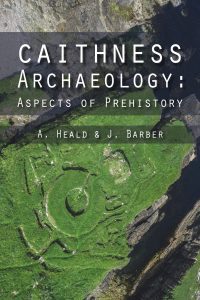Caithness Archaeology: Aspects of Prehistory by A Heald and J Barber, Whittles Publishing: Dunbeath, 2015. 168 pages, hardback. £20/$39.95. Reviewed by Peter Leeming.
This volume, a pioneering one for the archaeology of Caithness, states from the outset that it is selective in its approach rather than comprehensive in its coverage. The authors conclude that it is not ‘a guidebook or a holistic overview of the county’s riches’ (p150). They also note that it bounces around and is a journey through different archaeologies encountered. It attempts to deliver a flavour of the county, which is usually bypassed by ferry or rushed through on the way to the better-known wonders of the Northern Isles. Nevertheless, the intention is that readers should visit and explore for themselves. 
What is refreshing in this work is that the more recent discoveries and work by the people who actually live in the area, as opposed to the commercial and academic archaeologists who swoop in ahead of development for a frenetic period of activity, or the antiquarians and greats of archaeology, are celebrated. The invitation to visit some of them is generous of the authors and it is to be hoped that this wished-for stream of visitors will not be too onerous! The authors are very clear that they are incomers. The tone is for the interested lay reader and encourages the reader’s own interpretation of debates new and old. There are sly, knowing digs at academic archaeological disputes scattered throughout.
The definition of prehistory here may raise some eyebrows as it is taken up to c 1100 AD. This is an expanded version of the concept of the ‘long Iron Age’ which lasted up to the Viking incursions (Armit 2003). However, the book also strays beyond this into Viking evidence and even further in a short general survey in the introductory chapter. A perfectly good reason for this expanded time scale is that these are the periods which are encompassed in the multi-period sites that are found in the area, and the complexity of what is on view needs to be understood.
The book considers briefly the Mesolithic, then focuses on the Neolithic through the medium of the chambered tomb, including Heald and Barber’s experimental work on a new chambered cairn at Spittal and a discussion of some of the monuments in Caithness, principally Camster Long.
The Bronze Age is discussed more briefly, through cists, cairns, Beakers and the re-use of Neolithic monuments. The Iron Age section is dominated by brochs, but a wider perspective is attempted. There are additional chapters on other aspects such as Wags, wells and evidence of the Picts and Vikings. In all of these the work of antiquarians who worked in Caithness is presented, including Alexander Henry Rhind of Sibster, John Nicolson, Sir Francis Tress Barry, Robert Shearer and Joseph Anderson.
The final chapter of the book is not a mini-research agenda of the region, but rather draws attention to the idea that work carried out elsewhere could equally be undertaken in Caithness, with its unexplored promontory forts, hillforts, possible crannogs and hut circles being conventional categories for investigation. However, the authors repeat that the understanding of Caithness prehistory is biased. Burials and ritual monuments are known rather than settlements. The areas of Caithness covered by peat bogs are only referred to in passing, noting that many sites may be buried beneath the peat.
More curious are the omissions of recent work on the henge and underlying Late Mesolithic flint scatter at Pullyhour and thereby the inclusion of Caithness in a wider description of henge monuments in northern Scotland (Bradley and Lamdin-Whymark 2009; Bradley 2011) or any mention of souterrains amongst classic monument types which are found in Atlantic Scotland.
There are a few mistakes in the bibliography and sometimes works are referred to (eg by Trevor Cowie and Tress Barry) in the text with no corresponding entry. There is a curious error on page 35 where the Newgrange triple interlocking spiral carving is stated to be located at Maes Howe in Orkney. However, the most glaring omission is that the maps in general do not show where the sites being discussed are located. Only a couple of the maps are annotated. The lack of a ‘sites discussed in the text’ style of distribution map, for a book which explicitly points out that most people do not know the geography of the area, is particularly frustrating.
A final quibble is about access to further information. Although the reader is pointed towards suggested reading, some of these will only be located outside Caithness with difficulty. But perhaps that is the point. This is more a reference work for local people, to find out about the archaeology of their local area.
It is hoped that this entertaining and informative volume is successful and that this will spur on the authors to fully publish their excavations, which will further draw attention to Caithness’ archaeology. All royalties from the sale of the book will go to further activities of the Caithness Archaeological Trust, which is an additional excellent reason to buy it.
References:
Armit, I 2003 Towers in the North: the Brochs of Scotland. Stroud: Tempus Publishing.
Bradley, R 2011 Stages and Screens. An Investigation of Four Henge Monuments in Northern and North-Eastern Scotland. Edinburgh: Society of Antiquaries of Scotland.
Bradley, R & Lambdin-Whymark, H 2009 ‘Pullyhour – a signpost to the past’ PAST 61: 3-5.
Peter Leeming is currently an Honorary Research Fellow at the University of Exeter. He studied archaeology at Orkney College and worked for Aberdeenshire Archaeological Service and the Greater Manchester Archaeological Unit. He has recently completed a PhD thesis researching fossils discovered in Neolithic and Bronze Age sites in the British Isles, and undertaken fieldwork in the Republic of Georgia.
